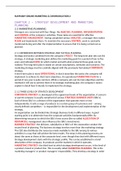Summary
Summary for Online Marketing & Communication 2
- Course
- Institution
- Book
This summary is for the course Online Marketing & Communication 2, in the second year. The summary is based on the book 'Marketing Fundamentals', written by Verhage. The summary is from chapters 2, 3, 6, 7, 8 & 11.
[Show more]




